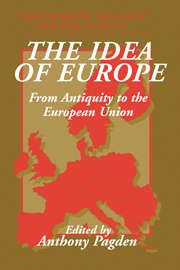Book contents
- Frontmatter
- Contents
- Acknowledgments
- Introduction
- 1 Europe: Conceptualizing a Continent
- 2 Some Europes in Their History
- 3 “Europe” in the Middle Ages
- 4 The Republican Mirror: The Dutch Idea of Europe
- 5 The Napoleonic Empire and the Europe of Nations
- 6 Homo Politicus and Homo Oeconomicus: The European Citizen According to Max Weber
- 7 The European Self: Rethinking an Attitude
- 8 European Nationalism and European Union
- 9 From the Ironies of Identity to the Identities of Irony
- 10 Muslims and European Identity: Can Europe Represent Islam?
- 11 The Long Road to Unity: The Contribution of Law to the Process of European Integration since 1945
- 12 The Euro, Economic Federalism, and the Question of National Sovereignty
- 13 Identity Politics and European Integration: The Case of Germany
- 14 Nationalisms in Spain: The Organization of Convivencia
- 15 The Kantian Idea of Europe: Critical and Cosmopolitan Perspectives
- Contributors
- Index
- Cambridge Cultural Social Studies
11 - The Long Road to Unity: The Contribution of Law to the Process of European Integration since 1945
Published online by Cambridge University Press: 14 July 2009
- Frontmatter
- Contents
- Acknowledgments
- Introduction
- 1 Europe: Conceptualizing a Continent
- 2 Some Europes in Their History
- 3 “Europe” in the Middle Ages
- 4 The Republican Mirror: The Dutch Idea of Europe
- 5 The Napoleonic Empire and the Europe of Nations
- 6 Homo Politicus and Homo Oeconomicus: The European Citizen According to Max Weber
- 7 The European Self: Rethinking an Attitude
- 8 European Nationalism and European Union
- 9 From the Ironies of Identity to the Identities of Irony
- 10 Muslims and European Identity: Can Europe Represent Islam?
- 11 The Long Road to Unity: The Contribution of Law to the Process of European Integration since 1945
- 12 The Euro, Economic Federalism, and the Question of National Sovereignty
- 13 Identity Politics and European Integration: The Case of Germany
- 14 Nationalisms in Spain: The Organization of Convivencia
- 15 The Kantian Idea of Europe: Critical and Cosmopolitan Perspectives
- Contributors
- Index
- Cambridge Cultural Social Studies
Summary
The formation of Europe—and of the European Communities and the Union that lie at the heart of the continent's political life—has largely been expressed in legal terms. In the space of more than fifty years, the antagonists of two savage world wars have so far merged their economies and some of their legal systems that any further conflict between the major European states is now almost unthinkable. It has instead become increasingly likely that, within the next few decades, full-scale economic, monetary, and political union will take place between the fifteen Member States of the European Union.
If, however, one had asked any of the leading European figures about their vision for Europe at various critical periods of the postwar era, one would have received rather different answers, largely conditioned by the wider geopolitical scene. It cannot, therefore, be said that there was a linear path from the rubble of 1945 to the vision of a federal United States of Europe that is emerging. Almost from the beginning the reassertion of national independence and sovereignty polarized states with a “federalist” vision of a United States or Confederation of Europe and those with an “intergovernmental” vision of a concert of states acting together in their mutual self-interest rather than as part of a wider union. This tension is far from resolved.
- Type
- Chapter
- Information
- The Idea of EuropeFrom Antiquity to the European Union, pp. 228 - 259Publisher: Cambridge University PressPrint publication year: 2002
- 2
- Cited by



